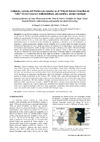Identificador persistente para citar o vincular este elemento:
https://accedacris.ulpgc.es/jspui/handle/10553/545
| Campo DC | Valor | idioma |
|---|---|---|
| dc.contributor.author | Mangas, José | en_US |
| dc.contributor.author | Menéndez González, Inmaculada | en_US |
| dc.contributor.author | Ortiz, J. E. | en_US |
| dc.contributor.author | Torres, T. | en_US |
| dc.date.accessioned | 2009-10-08T02:31:00Z | - |
| dc.date.accessioned | 2018-02-21T14:31:56Z | - |
| dc.date.available | 2018-02-21T14:31:56Z | - |
| dc.date.issued | 2008 | en_US |
| dc.identifier.issn | 1567-5172 | en_US |
| dc.identifier.other | 2069 | - |
| dc.identifier.uri | https://accedacris.ulpgc.es/handle/10553/545 | - |
| dc.description.abstract | Los niveles de eolianitas costeras de Tufia (Este de Gran Canaria) aparecen de forma dispersa en un área de 54,1 ha y presentan estratificaciones cruzadas de gran escala, bases erosivas, rizolitos y bandas con gasterópodos terrestres. Estos depósitos eólicos están constituidos por arenas de grano fino y, en menor medida, medio, y están entre bien y moderadamente seleccionadas. Los granos terrígenos predominan sobre los bioclastos en las eolianitas de Aguadulce y Botonera, y en los sedimentos de trasplaya, y tienen proporciones similares en las eolianitas de la Cantera. Entre los granos terrígenos destacan los fragmentos de rocas volcánicas básicas y de minerales ferromagnesianos, mientras que entre los bioclastos predominan las mallas de algas coralinas rojas y moluscos. Las edades definidas mediante análisis de racemización/epimerización de conchas de los géneros Theba y Hemicycla oscilan entre 31,2±6,2 y 39±8,8 Ka BP, por lo que son depósitos eólicos del Pleistoceno Superior, relacionados con las Aminozonas 3 y 4 establecidas para las Islas Canarias orientales y coincidentes con los Episodios de Heinrich 4 y 3. Por lo tanto, las eolianitas de Tufia se habrían formado durante una época de regresión marina y las dataciones corresponderían a la etapa isotópica OIS 3. | en_US |
| dc.description.abstract | Coastal aeolianite strata from Tufia (Eastern Gran Canaria Island) appear dispersed in an area of 54.1 hectares and they show large scale cross bedding, erosive bases, rhizoliths and terrestrial gastropod shells. These aeolian deposits are formed by fine grain sands and, in lower proportion, medium, and are between well and moderately sorted. The terrigenous grains predominate over bioclasts in the aeolianites of Aguadulce and Botonera, and in the backshore sediments, and these components appear in similar proportions at the Cantera. The volcanic basic rocks and ferromagnesian mineral fragments stand out as terrigenous grains, whereas, among bioclasts the red coralline algae and mollusc fragments predominate. The dates defined through racemization/epimerization analysis of Theba and Helicycla shells range between 31,2±6,2 y 39±8,8 Ka BP, that is why they are aeolian deposits of Upper Pleistocene, related to the 3 and 4 Aminozones established for oriental Canary Islands and coincident with 4 and 3 Heinrich Episodes. Therefore, Tufia aeoleanites would have been formed during a marine regression and the date would correspond with the OIS 3 isotopic stage. | en_US |
| dc.language | spa | en_US |
| dc.relation.ispartof | Geotemas (Madrid) | en_US |
| dc.source | Geotemas [ISSN 1567-5172], v 10, p. 1405-1408. | en_US |
| dc.subject | 2506 Geología | en_US |
| dc.subject.other | Coastal aeolianites | en_US |
| dc.subject.other | Sedimentology | en_US |
| dc.subject.other | Petrography | en_US |
| dc.subject.other | Aminocrhronology | en_US |
| dc.subject.other | Tufia | en_US |
| dc.title | Eolianitas costeras del Pleistoceno superior en el "Sitio de Interés Científico de Tufia" (Gran Canaria): sedimentología, petrografía y aminocronología | en_US |
| dc.title.alternative | Coastal aeolianites of Upper Pleistocene in the “Sitio de Interés Científico de Tufia” (Gran Canaria Island): sedimentology, petrography and aminochronology | en_US |
| dc.type | info:eu-repo/semantics/conferenceObject | en_US |
| dc.type | conferenceObject | en_US |
| dc.relation.conference | VII Congreso Geológico de España | en_US |
| dc.identifier.absysnet | 553523 | - |
| dc.identifier.crisid | 154;381;-;- | - |
| dc.description.lastpage | 1408 | en_US |
| dc.description.firstpage | 1405 | en_US |
| dc.relation.volume | 10 | en_US |
| dc.investigacion | Ciencias | en_US |
| dc.rights.accessrights | info:eu-repo/semantics/openAccess | es |
| dc.type2 | Actas de congresos | en_US |
| dc.description.numberofpages | 4 | en_US |
| dc.utils.revision | Sí | en_US |
| dc.identifier.supplement | 154;381;-;- | - |
| dc.identifier.supplement | 154;381;-;- | - |
| dc.identifier.supplement | 154;381;-;- | - |
| dc.identifier.supplement | 154;381;-;- | - |
| dc.identifier.ulpgc | Sí | en_US |
| dc.contributor.buulpgc | BU-BAS | en_US |
| item.grantfulltext | open | - |
| item.fulltext | Con texto completo | - |
| crisitem.author.dept | GIR IOCAG: Geología Aplicada y Regional | - |
| crisitem.author.dept | IU de Oceanografía y Cambio Global | - |
| crisitem.author.dept | Departamento de Física | - |
| crisitem.author.dept | GIR IOCAG: Geología Aplicada y Regional | - |
| crisitem.author.dept | IU de Oceanografía y Cambio Global | - |
| crisitem.author.dept | Departamento de Física | - |
| crisitem.author.orcid | 0000-0002-3286-743X | - |
| crisitem.author.orcid | 0000-0002-1801-5177 | - |
| crisitem.author.parentorg | IU de Oceanografía y Cambio Global | - |
| crisitem.author.parentorg | IU de Oceanografía y Cambio Global | - |
| crisitem.author.fullName | Mangas Viñuela, José | - |
| crisitem.author.fullName | Menéndez González, Inmaculada | - |
| crisitem.event.eventsstartdate | 14-07-2008 | - |
| crisitem.event.eventsenddate | 18-07-2008 | - |
| Colección: | Actas de congresos | |
Visitas
94
actualizado el 31-ago-2024
Descargas
217
actualizado el 31-ago-2024
Google ScholarTM
Verifica
Comparte
Exporta metadatos
Los elementos en ULPGC accedaCRIS están protegidos por derechos de autor con todos los derechos reservados, a menos que se indique lo contrario.
